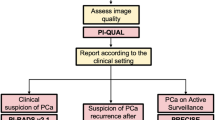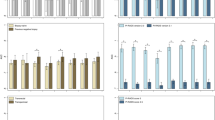Abstract
Purpose
To evaluate the role of 3D models on positive surgical margin rate (PSM) rate in patients who underwent robot-assisted radical prostatectomy (RARP) compared to a no-3D control group. Secondarily, we evaluated the postoperative functional and oncological outcomes.
Methods
Prospective study enrolling patients with localized prostate cancer (PCa) undergoing RARP with mp-MRI-based 3D model reconstruction, displayed in a cognitive or augmented-reality fashion, at our Centre from 01/2016 to 01/2020. A control no-3D group was extracted from the last two years of our Institutional RARP database. PSMr between the two groups was evaluated and multivariable linear regression (MLR) models were applied. Finally, Kaplan–Meier estimator was used to calculate biochemical recurrence at 12 months after the intervention.
Results
160 patients were enrolled in the 3D Group, while 640 were selected for the Control Group. A more conservative NS approach was registered in the 3D Group (full NS 20.6% vs 12.7%; intermediate NS 38.1% vs 38.0%; standard NS 41.2% vs 49.2%; p = 0.02). 3D Group patients had lower PSM rates (25 vs. 35.1%, p = 0.01). At MLR models, the availability of 3D technology (p = 0.005) and the absence of extracapsular extension (ECE, p = 0.004) at mp-MRI were independent predictors of lower PSMr. Moreover, 3D model represented a significant protective factor for PSM in patients with ECE or pT3 disease.
Conclusion
The availability of 3D models during the intervention allows to modulate the NS approach, limiting the occurrence of PSM, especially in patients with ECE at mp-MRI or pT3 PCa.



Similar content being viewed by others
References
Checcucci E, Amparore D, De Luca S, Autorino R, Fiori C, Porpiglia F (2019) Precision prostate cancer surgery: an overview of new technologies and techniques. Minerva Urol Nefrol 71(5):487–501. https://doi.org/10.23736/S0393-2249.19.03365-4
Lee S, Kim KB, Jo JK, Ho JN, Oh JJ, Jeong SJ, Hong SK, Byun SS, Choe G, Lee SE (2016) Prognostic value of focal positive surgical margins after radical prostatectomy. Clin Genitourin Cancer 14(4):e313–e319. https://doi.org/10.1016/j.clgc.2015.12.013
Dinneen E, Haider A, Grierson J, Freeman A, Oxley J, Briggs T, Nathan S, Williams NR, Brew-Graves C, Persad R, Aning J, Jamieson C, Ratynska M, Ben-Salha I, Ball R, Clow R, Allen C, Heffernan-Ho D, Kelly J, Shaw G (2020) NeuroSAFE frozen section during robot-assisted radical prostatectomy (RARP): Peri-operative and histopathological outcomes from the NeuroSAFE PROOF Feasibility Randomised Controlled Trial. BJU Int. https://doi.org/10.1111/bju.15256
Rocco B, Sighinolfi MC, Cimadamore A, ReggianiBonetti L, Bertoni L, Puliatti S, Eissa A, Spandri V, Azzoni P, Dinneen E, Shaw G, Nathan S, Micali S, Bianchi G, Maiorana A, Pellacani G, Montironi R (2020) Digital frozen section of the prostate surface during radical prostatectomy: a novel approach to evaluate surgical margins. BJU Int 126(3):336–338. https://doi.org/10.1111/bju.15108
Russo F, Manfredi M, Panebianco V, Armando E, De Luca S, Mazzetti S, Giannini V, Mele F, Bollito E, Appendino E, Regge D, Porpiglia F (2019) Radiological wheeler staging system: a retrospective cohort analysis to improve the local staging of prostate cancer with multiparametric MRI. Minerva Urol Nefrol 71(3):264–272. https://doi.org/10.23736/S0393-2249.19.03248-X
Porpiglia F, Bertolo R, Checcucci E, Amparore D, Autorino R, Dasgupta P, Wiklund P, Tewari A, Liatsikos E, Fiori C, ESUT Research Group (2018) Development and validation of 3D printed virtual models for robot-assisted radical prostatectomy and partial nephrectomy: urologists’ and patients’ perception. World J Urol. https://doi.org/10.1007/s00345-017-2126-1
Porpiglia F, Checcucci E, Amparore D, Manfredi M, Massa F, Piazzolla P, Manfrin D, Piana A, Tota D, Bollito E, Fiori C (2019) Three-dimensional elastic augmented-reality robot-assisted radical prostatectomy using hyperaccuracy three-dimensional reconstruction technology: a step further in the identification of capsular involvement. Eur Urol 76(4):505–514. https://doi.org/10.1016/j.eururo.2019.03.037
Porpiglia F, Checcucci E, Amparore D, Autorino R, Piana A, Bellin A, Piazzolla P, Massa F, Bollito E, Gned D, De Pascale A, Fiori C (2019) Augmented-reality robot-assisted radical prostatectomy using hyper-accuracy three-dimensional reconstruction (HA3D™) technology: a radiological and pathological study. BJU Int 123(5):834–845. https://doi.org/10.1111/bju.14549 (Epub 2018 Oct 19 PMID: 30246936)
Amparore D, Pecoraro A, Checcucci E et al (2021) 3D imaging technologies in minimally-invasive kidney and prostate cancer surgery: which is the urologists’ perception? Minerva Urol Nefrol. https://doi.org/10.23736/S2724-6051.21.04131-X
Russo F, Regge D, Armando E, Giannini V, Vignati A, Mazzetti S, Manfredi M, Bollito E, Correale L, Porpiglia F (2016) Detection of prostate cancer index lesions with multiparametric magnetic resonance imaging (mp-MRI) using whole-mount histological sections as the reference standard. BJU Int 118(1):84–94. https://doi.org/10.1111/bju.13234
Porpiglia F, Bertolo R, Manfredi M, De Luca S, Checcucci E, Morra I, Passera R, Fiori C (2016) Total anatomical reconstruction during robot-assisted radical prostatectomy: implications on early recovery of urinary continence. Eur Urol 69(3):485–495. https://doi.org/10.1016/j.eururo.2015.08.005
Austin PC (2011) An introduction to propensity score methods for reducing the effects of confounding in observational studies. Multivar Behav Res 46(3):399–424. https://doi.org/10.1080/00273171.2011.568786
Montorsi F, Wilson TG, Rosen RC, Ahlering TE, Artibani W, Carroll PR, Costello A, Eastham JA, Ficarra V, Guazzoni G, Menon M, Novara G, Patel VR, Stolzenburg JU, Van der Poel H, Van Poppel H, Mottrie A, Pasadena Consensus Panel (2012) Best practices in robot-assisted radical prostatectomy: recommendations of the Pasadena Consensus Panel. Eur Urol. https://doi.org/10.1016/j.eururo.2012.05.057
Dindo D, Demartines N, Clavien PA (2004) Classification of surgical complications: a new proposal with evaluation in a cohort of 6336 patients and results of a survey. Ann Surg 240(2):205–213. https://doi.org/10.1097/01.sla.0000133083.54934.ae.PMID:15273542;PMCID:PMC1360123
Martini A, Gandaglia G, Fossati N, Scuderi S, Bravi CA, Mazzone E, Stabile A, Scarcella S, Robesti D, Barletta F, Cucchiara V, Mirone V, Montorsi F, Briganti A (2019) Defining clinically meaningful positive surgical margins in patients undergoing radical prostatectomy for localised prostate cancer. Eur Urol Oncol. https://doi.org/10.1016/j.euo.2019.03.006
Rosen RC, Riley A, Wagner G, Osterloh IH, Kirkpatrick J, Mishra A (1997) The international index of erectile function (IIEF): a multidimensional scale for assessment of erectile dysfunction. Urology 49(6):822–830. https://doi.org/10.1016/s0090-4295(97)00238-0
Wang S, Frisbie J, Keepers Z, Bolten Z, Hevaganinge A, Boctor E, Leonard S, Tokuda J, Krieger A, Siddiqui MM (2020) The Use of three-dimensional visualization techniques for prostate procedures: a systematic review. Eur Urol Focus. https://doi.org/10.1016/j.euf.2020.08.002
Kratiras Z, Gavazzi A, Belba A, Willis B, Chew S, Allen C, Amoroso P, Dasgupta P (2019) Phase I study of a new tablet-based image guided surgical system in robot-assisted radical prostatectomy. Minerva Urol Nefrol 71(1):92–95. https://doi.org/10.23736/S0393-2249.18.03250-2
Ukimura O, Gill IS (2008) Imaging-assisted endoscopic surgery: Cleveland Clinic experience. J Endourol 22(4):803–810. https://doi.org/10.1089/end.2007.9823
Teber D, Simpfendörfer T, Guven S, Baumhauer M, Gözen AS, Rassweiler J (2010) In-vitro evaluation of a soft-tissue navigation system for laparoscopic prostatectomy. J Endourol 24(9):1487–1491. https://doi.org/10.1089/end.2009.0289
Simpfendörfer T, Baumhauer M, Müller M, Gutt CN, Meinzer HP, Rassweiler JJ, Guven S, Teber D (2011) Augmented reality visualization during laparoscopic radical prostatectomy. J Endourol 25(12):1841–1845. https://doi.org/10.1089/end.2010.0724
Lanchon C, Custillon G, Moreau-Gaudry A, Descotes JL, Long JA, Fiard G, Voros S (2016) Augmented reality using transurethral ultrasound for laparoscopic radical prostatectomy: preclinical evaluation. J Urol 196(1):244–250. https://doi.org/10.1016/j.juro.2016.01.094
Amparore D, Checcucci E, Fiori C, Porpiglia F, Francesco P, Enrico C, Daniele A et al (2020) Three-dimensional Augmented Reality Robot-assisted Partial Nephrectomy in Case of Complex Tumours (PADUA ≥ 10): A New Intraoperative Tool Overcoming the Ultrasound Guidance. Eur Urol. In press. Eur Urol 77(6):e163–e164. https://doi.org/10.1016/j.eururo.2020.03.038
Porpiglia F, Checcucci E, Amparore D, Piazzolla P, Manfredi M, Pecoraro A, De Cillis S, Piana A, Volpi G, Piramide F, Alessio P, Granato S, Vezzetti E, Fiori C (2021) P1100-Artificial intelligence guided 3D automatic augmented-reality images allow to identify the extracapsular extension on neurovascular bundles during robotic prostatectomy. Eur Urol 79(Supplement):1. https://doi.org/10.1016/S0302-2838(21)01471-8
Bianchi L, Chessa F, Angiolini A, Cercenelli L, Lodi S, Bortolani B, Molinaroli E, Casablanca C, Droghetti M, Gaudiano C, Mottaran A, Porreca A, Golfieri R, Romagnoli D, Giunchi F, Fiorentino M, Piazza P, Puliatti S, Diciotti S, Marcelli E, Mottrie A, Schiavina R (2021) The use of augmented reality to guide the intraoperative frozen section during robot-assisted radical prostatectomy. Eur Urol. https://doi.org/10.1016/j.eururo.2021.06.020
Schiavina R, Bianchi L, Lodi S, Cercenelli L, Chessa F, Bortolani B, Gaudiano C, Casablanca C, Droghetti M, Porreca A, Romagnoli D, Golfieri R, Giunchi F, Fiorentino M, Marcelli E, Diciotti S, Brunocilla E (2020) Real-time augmented reality three-dimensional guided robotic radical prostatectomy: preliminary experience and evaluation of the impact on surgical planning. Eur Urol Focus. https://doi.org/10.1016/j.euf.2020.08.004
Morozov A, Barret E, Veneziano D, Grigoryan V, Salomon G, Fokin I, Taratkin M, Poddubskaya E, Gomez Rivas J, Puliatti S, Okhunov Z, Cacciamani GE, Checcucci E, Marenco Jiménez JL, Enikeev D, In collaboration with ESUT-YAUWP Group (2021) A systematic review of nerve-sparing surgery for high-risk prostate cancer. Minerva Urol Nefrol. https://doi.org/10.23736/S0393-2249.20.04178-8
Checcucci E, Autorino R, Cacciamani GE, Amparore D, De Cillis S, Piana A, Piazzolla P, Vezzetti E, Fiori C, Veneziano D, Tewari A, Dasgupta P, Hung A, Gill I, Porpiglia F, Uro-technology and SoMe Working Group of the Young Academic Urologists Working Party of the European Association of Urology (2020) Artificial intelligence and neural networks in urology: current clinical applications. Minerva Urol Nefrol. https://doi.org/10.23736/S0393-2249.19.03613-0
Checcucci E, De Cillis S, Granato S, Chang P, Afyouni AS, Okhunov Z, o-technology and SoMe Working Group of the Young Academic Urologists Working Party of the European Association of Urology (2020) Applications of neural networks in urology: a systematic review. Curr Opin Urol. https://doi.org/10.1097/MOU.0000000000000814 (PMID: 32881726)
Author information
Authors and Affiliations
Consortia
Contributions
Protocol/project development: EC, DA, AP, FP. Data collection or management: SDC, SG, MS, AP, PV. Data analysis: AP. Manuscript writing/editing: EC, GV, AP. Supervision: CF, MDD, MM, PP, EV, FP.
Corresponding author
Ethics declarations
Conflict of interest
All the authors have nothing to disclose.
Research involving human participants and/or animals
None.
Informed consent
None.
Additional information
Publisher's Note
Springer Nature remains neutral with regard to jurisdictional claims in published maps and institutional affiliations.
Supplementary Information
Below is the link to the electronic supplementary material.
Rights and permissions
About this article
Cite this article
Checcucci, E., Pecoraro, A., Amparore, D. et al. The impact of 3D models on positive surgical margins after robot-assisted radical prostatectomy. World J Urol 40, 2221–2229 (2022). https://doi.org/10.1007/s00345-022-04038-8
Received:
Accepted:
Published:
Issue Date:
DOI: https://doi.org/10.1007/s00345-022-04038-8




